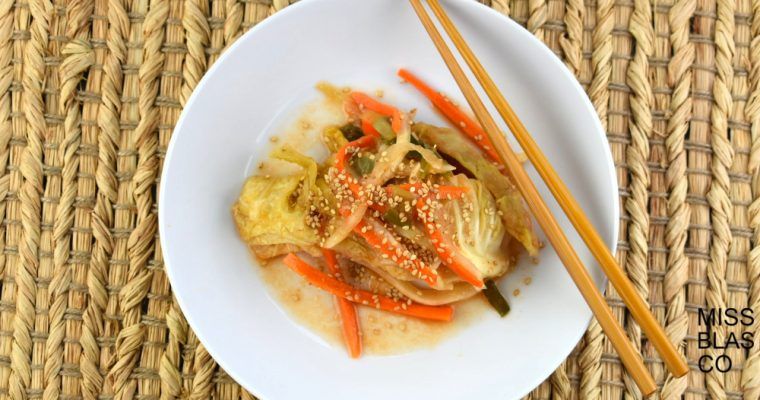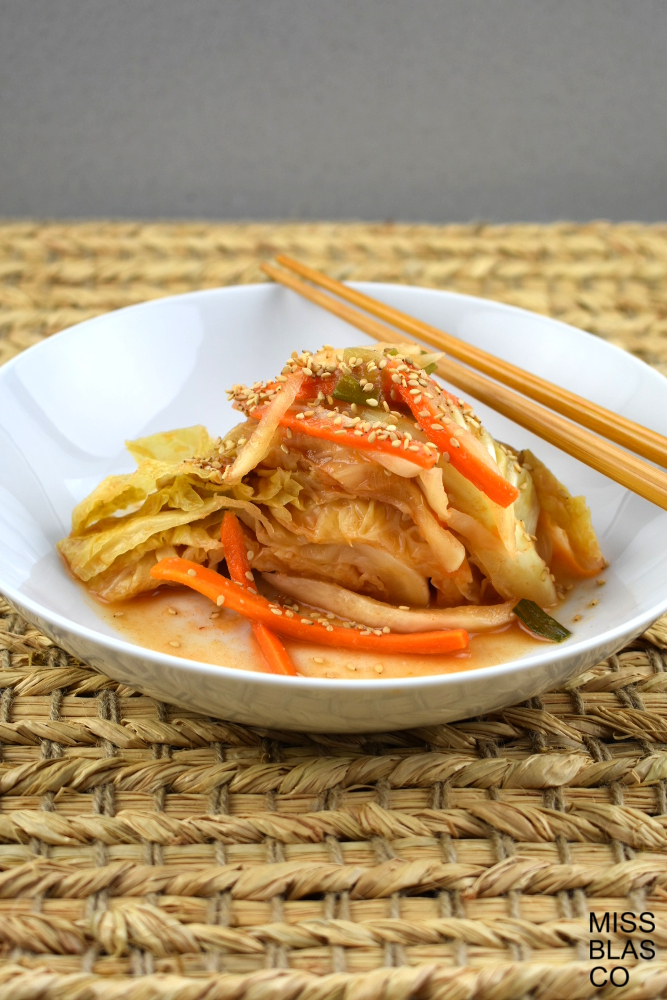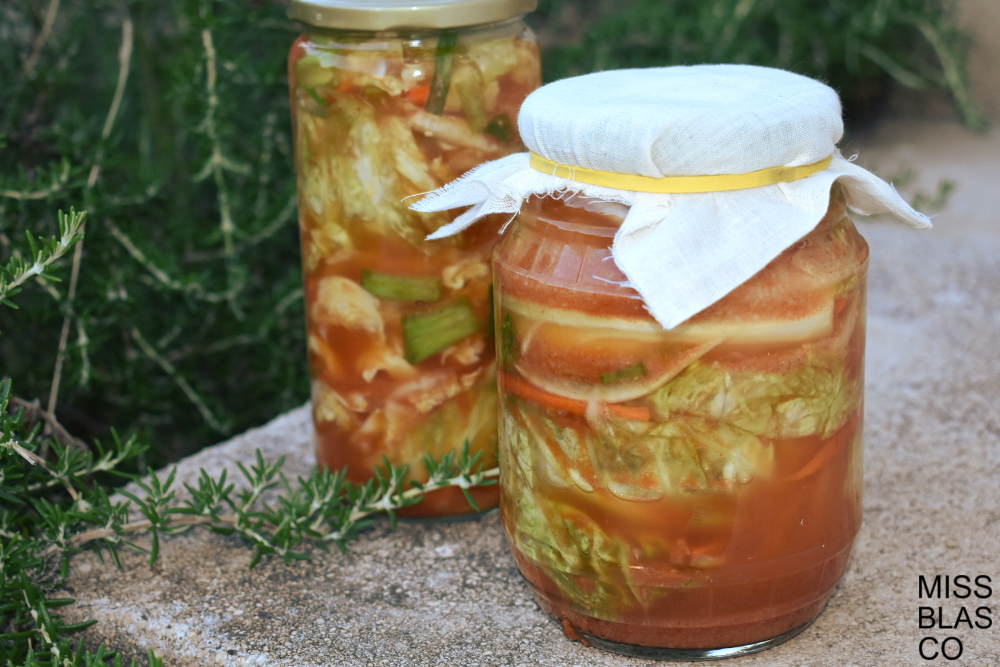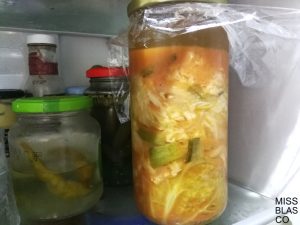
HOW TO MAKE KIMCHI EASY (RECIPE)
In this post I want to teach you how to make an easy kimchi, without complicating yourself too much, with easy to get ingredients.
Kimchi is the most famous and most international Korean dish, you can eat kimchi practically in any city in the world, it is strong and spicy, and it is usually served as a garnish to accompany other dishes.
Making a kimchi at home is relatively simple, it is about marinating cabbage along with other vegetables in a paste that has garlic, ginger, cayenne, chives and rice grits.
Kimchi is fermented cabbage, with a salty, spicy and very tasty paste.
The cabbage is left in brine for a few hours to soften and release water, and then it is rinsed and mixed with the spicy paste, it is kept in a container at room temperature for 48 hours, so that it makes a first fermentation.
The ideal temperature for the process to start is between 18 and 20ºC, if it is warmer, perhaps 24 hours of fermentation at room temperature is enough.
After two days, you will see that when you press the cabbage into the fermentation liquid, little bubbles come out, congratulations! the process has started successfully, now you can store it in the fridge so that it continues fermenting.

What is lactic fermentation:
The vegetables that are conserved in a salty medium, undergo a lactic fermentation process, said fermentation takes place in the cytoplasm of the cell and consists of the degradation of glucose to obtain metabolic energy and the production of lactic acid.
When kimchi ferments, its organoleptic characteristics change and its flavor improves.
To make it easier for you to understand, fermentation breaks down the monosaccharides, disaccharides, oligo-saccharides and polysaccharides (starches) in the food into lactic acid.
It breaks down glucose, fructose, and galactose (what we know as sugars) from food to lactic acid.
Lactic acid causes any decomposition process, (the appearance of harmful microorganisms), to stop and therefore the food is preserved for long periods of time. This is because it lowers the pH of the medium, acidifies it.
This entire process occurs in an anaerobic environment, that is, without oxygen, so the food must be immersed in the maceration liquid at all times.
The bacteria responsible for this process are called lactic acid bacteria.
In the specific case of kimchi, almost 20 years ago, the bacteria was isolated, which, along with other lactic acid bacteria (Streptococcus, Weissella and some species of Lactobacillus), it is responsible for giving it the organoleptic characteristics it has, it is the Lactobacillus kimchii.
It is the most famous dish in Korea and there are many different recipes, I propose this easy kimchi.
As you can imagine, being kimchi the most famous dish in Korea, there are hundreds of recipes and they vary according to the area, in the north a more "watery" kimchi is made, with less salt and less cayenne, without shellfish.
On the other hand, in the south of the country, kimchi is prepared with a denser and spicier sauce and also usually has seafood in brine or fermented anchovies and their juice.
In the way you prefer, I encourage you to try it, my recipe is very simple, with ingredients that you have at your fingertips.
A good idea is to spend the weekend preparing it with ease, and then save it for weeks or months to consume it little by little.

What I like the most is seeing how the nuances of its flavor change as the days go by.
It is important that you try the pasta when you are making it to calibrate the level of spiciness, but do not panic if it seems very strong at first.
As it ferments, as the bacteria do their work, the flavor will change, new nuances will emerge, and it will be much richer.
Kimchi provides live microorganisms that improve the intestinal microbiota.
Kimchi benefits:
As it is a fermented food, kimchi has a number of benefits, mainly the contribution of live microorganisms that contribute to the improvement of our intestinal microbiota.
It is considered an adequate food in the treatment of inflammatory diseases and the power of the Lactobacillus to fight fungal infections like Candida.
- Provides lactic acid.
- Contains Vitamin C, A, B1 and B2.
- It is a source of carotenes.
- It provides few calories and is rich in water.
Its high salt content is also remarkable, since it is the result of a lactic fermentation process in a salty medium, make sure to wash the cabbage well after the first step, so you will better control this point.
How to consume kimchi:
- As is, pour yourself a serving and enjoy it.
- Accompanied by quinoa or any other whole grain cereal of your choice, (rice, for example).
- Adding a portion to a tofu soup, or accompanied by marinated and sautéed tofu.
- With a noodle soup.
Why I like this recipe so much:
- Because, like all fermented, it is a live food that provides a great variety of microorganisms.
- Because I can control the ingredients and the fermentation times obtaining different results.
- It brings different flavors and textures to my dishes.
- It is kept for a long time in the refrigerator, it can be months.
- It can be consumed alone or accompanied by other foods, it can also be added to soups and broths.
Related entries:
If you want more information, I leave you some interesting links:

EASY KIMCHI
Ingredients
For the base
- 700 g Chinese cabbage (Akusay) (1 unit) If you can't find it, use kale or plain cabbage.
- 1 cup coarse sea salt (you may not use it all)
- 150 g white turnip (1 large unit)
- 125 g carrot (2 units)
- 100 g chive The green part, the stems
For the pasta
- 1/2 tbsp ground cayenne (if you do not have ground cayenne, add between 4 and 6 dried chillies)
- 1/2 tbsp cayenne pepper (the spanish touch, totally optional)
- 4 tbsp soy sauce (Korean fish sauce is usually used in the original recipe, but if you want a vegan recipe, use the soy one)
- 1/2 cup cooked white rice
- 3 cup rice cooking water (cook the rice with salt water, in the original recipe of use semolina rice)
- 50 g it (3 garlic cloves)
- 50 g chive (1 unit)
- 50 g fresh ginger
Elaboration step by step
- The first thing you should do is wash the cabbage and cut it into quarters. If it is very large, cut each quarter in half, lengthwise. In this way, when the kimchi is made, you will have large pieces of cabbage that you can cut as you like to consume.

- Spread the coarse salt all over the cabbage, smear on the outside and put salt between the leaves, carefully separate the leaves and add salt.Let the cabbage marinate with the salt for about 5-6 hours at room temperature.

- After that time, the cabbage will have lost water and will have softened, it is time to rinse it to remove excess salt.
- Now is the time to cut the rest of the vegetables, the finer the better, you can also grate them.

- Cook the white round rice in salted water for approximately 20 minutes, and reserve.
- On the other hand we make the pasta for the kimchi. In a food processor we add the garlic, fresh ginger, chives, cayenne, paprika (optional), soy sauce, cooked rice and the rice's cooking water. Shred well.

- The next step is to mix the julienned or grated vegetables with the paste that we have just made and smear the cabbage. Do it with your hands and be sure to spread the mixture between the cabbage leaves.

- The idea is that the cabbage is submerged in liquid, so if you see that the pasta you have made is not enough, do more. This will depend on the size of the cabbage you use.
- Put the cabbage well smeared in the sauce in glass jars, or in a flat container, preferably glass, cover it and leave to ferment for 48 hours at room temperature. If it is summer and it is very hot, 24 hours may be enough, see how it goes, if pressing the cabbage into the liquid bubbles come out, it is already beginning to ferment.

- After this first step, keep the kimchi in the fridge, try to make it well submerged in the liquid, the easiest thing is to keep it in glass jars, put a cabbage leaf on the top layer and add some element that exerts pressure, for example, a piece of large turnip or a piece of carrot. If you have special containers to ferment, you don't need to do any of these tricks.

- Once you have the kimchi in the refrigerator, the fermentation process will continue, but more slowly, you can keep it for a long time, and you will notice that as the days go by, the flavor will vary, the bacteria work and the organoleptic characteristics of the mixture.

Natalia
Being a fermented food and changing its composition, it loses part of its internal properties and breaks down fructose, galactose and glucose, my question is, could people with fructose malabsorption and lactose intolerance take it as a good food?
missblasco
When there is lactose intolerance and fructose malabsorption, the dietary protocols to follow are complex, depending on the degree of affectation, a low-FODMAP diet can be prescribed by a specialist who will control the different phases of the process. Vegetables when fermenting change their properties, but that does not mean that they are necessarily suitable in all cases, so I cannot say that kimchi is suitable for you. Greetings!
Patricia Perez
It looks very good, but it has a lot of salt as I see in the nutritional table that you add. This would be a very negative aspect of this food.
missblasco
Hello Patricia, salt has a function, it is used to rub the cabbage with it and let it “sweat”, when it has already lost water, it is rinsed to remove that excess salt (step 3 of the recipe).
Best regards.